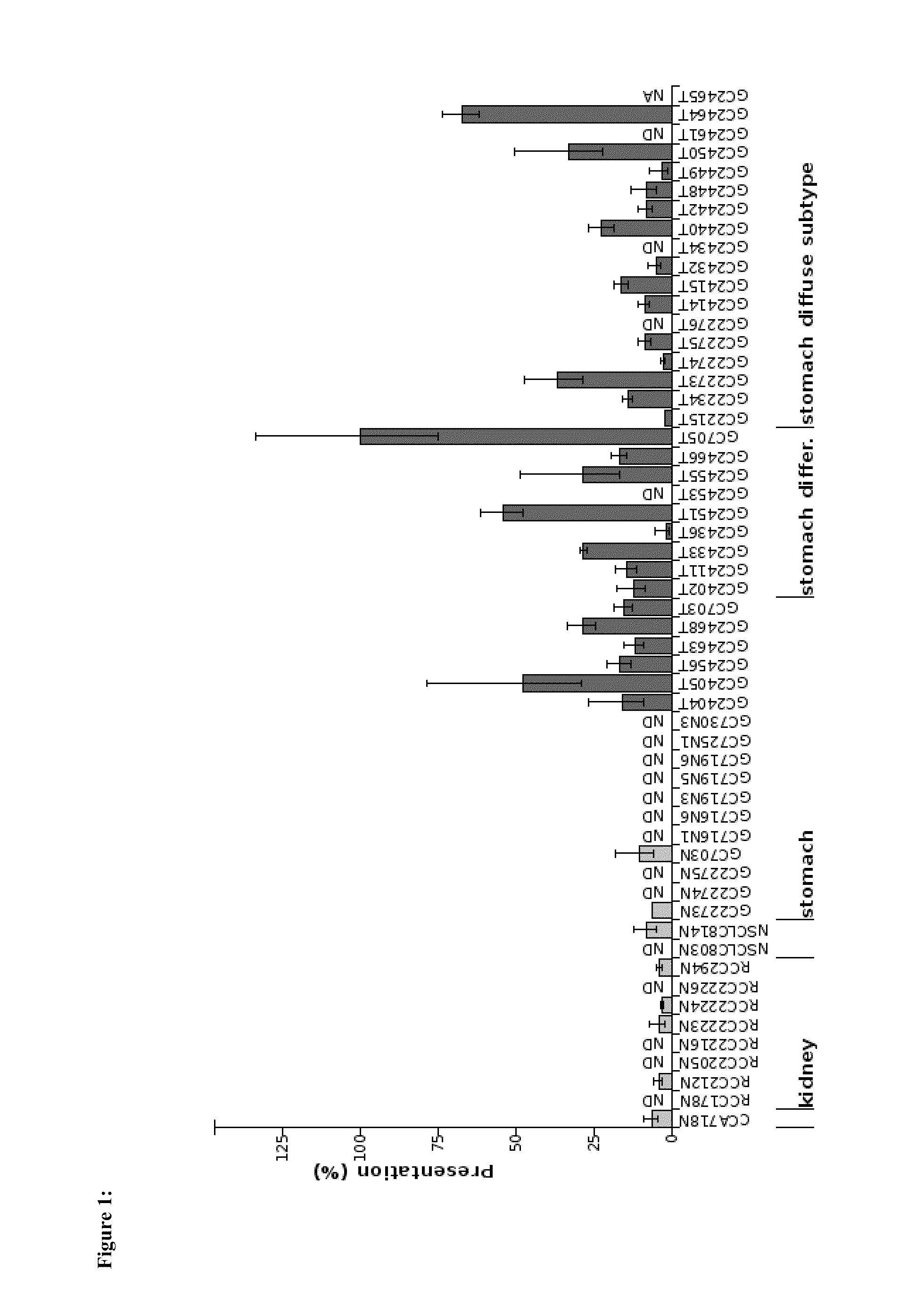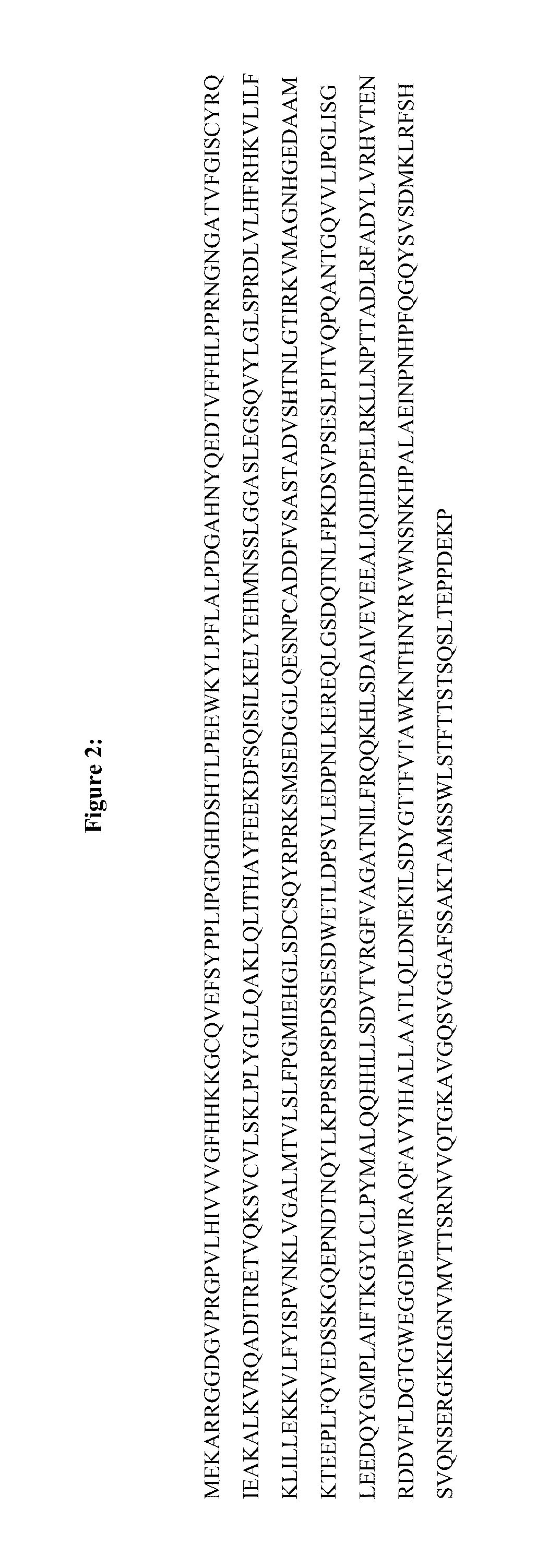Methods for the diagnosis and treatment of cancer based on AVL9
a cancer and avl9 technology, applied in the field of mammals' cancer diagnosis and treatment, can solve the problems of continuing to pose a major challenge for healthcare professionals, and patients have a high likelihood of local and systemic relaps
- Summary
- Abstract
- Description
- Claims
- Application Information
AI Technical Summary
Problems solved by technology
Method used
Image
Examples
example 1
Identification of Tumor Associated Peptides Presented on Cell Surface
[0176]Tissue Samples
[0177]Patients' tumor tissues were provided by Kyoto Prefectural University of Medicine (KPUM), Kyoto, Japan, and Osaka City University Graduate School of Medicine (OCU), Osaka, Japan. Written informed consents of all patients had been given before surgery. Tissues were shock-frozen in liquid nitrogen immediately after surgery and stored until isolation of TUMAPs at −80° C.
[0178]Isolation of HLA Peptides from Tissue Samples
[0179]HLA peptide pools from shock-frozen tissue samples were obtained by immune precipitation from solid tissues according to a slightly modified protocol (Falk et al., 1991) (Seeger et al., 1999) using the HLA-A, -B, -C-specific antibody W6 / 32, CNBr-activated sepharose, acid treatment, and ultrafiltration.
Sequence Identification
[0180]The HLA peptide pools as obtained were separated according to their hydrophobicity by reversed-phase chromatography (Acquity HPLC system, Water...
example 2
Expression Profiling of Genes Encoding the Peptides of the Invention
[0186]Not all peptides identified as being presented on the surface of tumor cells by MHC molecules are suitable for immunotherapy, because the majority of these peptides are derived from normal cellular proteins expressed by many cell types. Only few of these peptides are tumor-associated and likely able to induce T cells with a high specificity of recognition for the tumor from which they were derived. In order to identify such peptides and minimize the risk for autoimmunity induced by vaccination the inventors focused on those peptides that are derived from proteins that are over-expressed on tumor cells compared to the majority of normal tissues.
[0187]The ideal peptide will be derived from a protein that is unique to the tumor and not present in any other tissue. To identify peptides that are derived from genes with an expression profile similar to the ideal one the identified peptides were assigned to the prote...
example 3
In Vitro Immunogenicity for MHC Class I Presented Peptides
[0194]To get information regarding the immunogenicity of the TUMAPs of the present invention, the inventors performed investigations using a well established in vitro stimulation platform already described by (Walter, S, Herrgen, L, Schoor, O, Jung, G, Wernet, D, Buhring, H J, Rammensee, H G, and Stevanovic, S; 2003, Cutting edge: predetermined avidity of human CD8 T cells expanded on calibrated MHC / anti-CD28-coated microspheres, J. Immunol., 171, 4974-4978). This way the inventors could show immunogenicity for 32 HLA-A*2402 restricted TUMAPs of the invention demonstrating that these peptides are T-cell epitopes against which CD8+ precursor T cells exist in humans (Table 4).
[0195]In vitro priming of CD8+ T cells In order to perform in vitro stimulations by artificial antigen presenting cells (aAPC) loaded with peptide-MHC complex (pMHC) and anti-CD28 antibody, the inventors first isolated CD8 T cells from fresh HLA-A*24 leuka...
PUM
| Property | Measurement | Unit |
|---|---|---|
| Fraction | aaaaa | aaaaa |
| Digital information | aaaaa | aaaaa |
| Length | aaaaa | aaaaa |
Abstract
Description
Claims
Application Information
 Login to View More
Login to View More - R&D
- Intellectual Property
- Life Sciences
- Materials
- Tech Scout
- Unparalleled Data Quality
- Higher Quality Content
- 60% Fewer Hallucinations
Browse by: Latest US Patents, China's latest patents, Technical Efficacy Thesaurus, Application Domain, Technology Topic, Popular Technical Reports.
© 2025 PatSnap. All rights reserved.Legal|Privacy policy|Modern Slavery Act Transparency Statement|Sitemap|About US| Contact US: help@patsnap.com



